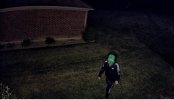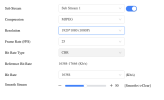Based on this thread about the lower end 2449-PRO and the better 3449-PRO, many of us wanted to see how it would perform in our situations instead of ideal situations in a marketing video.
The EmpireTech 4M-T camera boasts the following:
My first impressions are that the image is comparable to the original 5442 fixed lens camera, but it benefits from a better sensor (but not the S3) along with stronger infrared.
I have found this two-way talk to be the fastest of any of the other cameras I have with two-way talk. It didn't suffer from the lag that many of us are used to.
The speaker is fairly loud for a turret. Not as loud as the 4K/X bullet, but louder than the 180T.
The red/white flashing light is way brighter than the previous TIOC cameras. The first generation you could only really see the flashing if you looked up at the camera. This one illuminates the area around the camera and the light can be seen reflecting off the neighboring house. The previous TIOC had no chance at doing that. In the front of the house, one may think it is police heading that way.
I have stated this before, but the more I play with the new GUI on my other cameras that have the new GUI (4K-T, mini-PTZ, T180) the more I start to like it. It has way more options and flexibility. It still has some quirks as well LOL.
This model has AcuPick like the other models with the newer GUI, but as mentioned, you need an NVR capable of using this feature for it to work.
I won't bore you with the GUI screenshots as they are getting fairly standard across the board now with the new GUI.
Here are some first impression night pics while I work on getting some additional comparisons.
As usual, I am using my two-faced neighbor as the model LOL. This time it is his kid doing a light jog/fast walk for these images. Settings are 1/120 shutter, 0-50 gain, 40 NR. Other settings adjusted a few off of default 50.
The first image is just the infrared - you will notice a tree shadow in the background that is from another camera, but the house is blocking it from providing any additional lighting to the person at these locations:

The next is the white LED but on auto day/night so it stayed in B/W. This allows you to see some features on the clothing that was lost with infrared:

This is forcing the camera into color with the white LED on. While the B/W can see a little further out, I like this image better (although some may not like the white light):

And then one of the things we talk about is the exposure can get messed up with the flashing light a bit, but it also shows how much stronger it is than previous TIOC:

I am still playing with it and will try a few more things, but a quick summary is this is the first TIOC that I think we can recommend. Previous TIOCs suffered from less than ideal MP/sensor ratios and this is the first one I recall that is on the ideal MP/sensor ratio.
This one is giving us the image quality of the 5442, but adds a speaker, which many people like.
The ability to use white light or infrared is a huge selling point.
The additional TIOC features are bonuses if you want to use them.
The price-point is basically the same as the 5442, but with these additional features. I am a big fan of at least one camera with a speaker on each side of the house to hopefully send out alarms and this one provides the image quality that was lacking on many other cameras with that feature.
The EmpireTech 4M-T camera boasts the following:
- 4MP on the ideal 1/1.8" sensor
- Two-way talk
- Infrared and white light
- Red/blue siren lights
- Audio alarm capabilities
My first impressions are that the image is comparable to the original 5442 fixed lens camera, but it benefits from a better sensor (but not the S3) along with stronger infrared.
I have found this two-way talk to be the fastest of any of the other cameras I have with two-way talk. It didn't suffer from the lag that many of us are used to.
The speaker is fairly loud for a turret. Not as loud as the 4K/X bullet, but louder than the 180T.
The red/white flashing light is way brighter than the previous TIOC cameras. The first generation you could only really see the flashing if you looked up at the camera. This one illuminates the area around the camera and the light can be seen reflecting off the neighboring house. The previous TIOC had no chance at doing that. In the front of the house, one may think it is police heading that way.
I have stated this before, but the more I play with the new GUI on my other cameras that have the new GUI (4K-T, mini-PTZ, T180) the more I start to like it. It has way more options and flexibility. It still has some quirks as well LOL.
This model has AcuPick like the other models with the newer GUI, but as mentioned, you need an NVR capable of using this feature for it to work.
I won't bore you with the GUI screenshots as they are getting fairly standard across the board now with the new GUI.
Here are some first impression night pics while I work on getting some additional comparisons.
As usual, I am using my two-faced neighbor as the model LOL. This time it is his kid doing a light jog/fast walk for these images. Settings are 1/120 shutter, 0-50 gain, 40 NR. Other settings adjusted a few off of default 50.
The first image is just the infrared - you will notice a tree shadow in the background that is from another camera, but the house is blocking it from providing any additional lighting to the person at these locations:

The next is the white LED but on auto day/night so it stayed in B/W. This allows you to see some features on the clothing that was lost with infrared:

This is forcing the camera into color with the white LED on. While the B/W can see a little further out, I like this image better (although some may not like the white light):

And then one of the things we talk about is the exposure can get messed up with the flashing light a bit, but it also shows how much stronger it is than previous TIOC:

I am still playing with it and will try a few more things, but a quick summary is this is the first TIOC that I think we can recommend. Previous TIOCs suffered from less than ideal MP/sensor ratios and this is the first one I recall that is on the ideal MP/sensor ratio.
This one is giving us the image quality of the 5442, but adds a speaker, which many people like.
The ability to use white light or infrared is a huge selling point.
The additional TIOC features are bonuses if you want to use them.
The price-point is basically the same as the 5442, but with these additional features. I am a big fan of at least one camera with a speaker on each side of the house to hopefully send out alarms and this one provides the image quality that was lacking on many other cameras with that feature.
Last edited:
As an Amazon Associate IPCamTalk earns from qualifying purchases.



